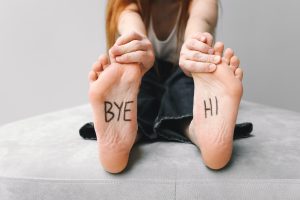 Throughout the years, our personal trainers at LIV Fitness in Dublin, CA, have worked with people with issues that impeded their mobility. They created a personalized workout with modifications to address those issues. Problems often faced are issues with feet and ankles. You don’t have to give up working out, so don’t use it as an excuse not to exercise if that’s your problem. There is a way to exercise with bad feet and have a thorough workout.
Throughout the years, our personal trainers at LIV Fitness in Dublin, CA, have worked with people with issues that impeded their mobility. They created a personalized workout with modifications to address those issues. Problems often faced are issues with feet and ankles. You don’t have to give up working out, so don’t use it as an excuse not to exercise if that’s your problem. There is a way to exercise with bad feet and have a thorough workout.
Running and other high-impact exercises often create bad feet.
There are a lot of reasons that your feet might hurt. It can be anything from a temporary cause, like a cut or something more permanent. One thing you don’t want to do is exacerbate the injury. Many runners experience the problem after years of the high-impact pounding their feet take when they run. Avoid that pounding by switching to low-impact workouts or modifying existing workouts. Swimming is low impact, for instance. Modifying position your position works, too. Switch standing butt kicks for donkey kicks on hands and knees.
There are lower body exercises that don’t involve standing.
Whether you’re sitting in a chair or lying on the floor, you won’t be putting pressure on your feet. Doing leg raises laying on your side is one of those exercises that work the legs without putting any pressure on the feet. Seated heel presses, leg extensions and knee lifts are a few that can be done while seated. You can even modify a plank or push-up by resting your weight on your knees, not your feet.
Get fit and build strength whether sitting or lying on the floor.
Seated leg lifts are tough and don’t put any pressure on the feet. Most upper-body workouts can be done seated, too. Air boxing, seated jumping jacks without the jump, bicep curls and many more exercises can be modified to protect your feet and build strength. Lay on the floor and put your feet on a chair or bench. Do a modified bridge by lifting your bottom off the ground and forming a straight 45-degree angle from your shoulders to your feet. It’s more of a workout than the traditional chair, so people without injuries might want to try it.
- Don’t forget to warm up and stretch. Staying flexible is important. It’s also important to maintain motion in the ankles, since you aren’t working them as hard with a foot injury. Doing ankle curls and outstretching the legs and making circles are good exercises.
- Always check with your healthcare professional before starting any program of exercise. Don’t push yourself if you feel pain, particularly if the pain comes from the injured area.
- Do leg lifts seated for lower body workouts. Add an upper body workout by grasping the side of the chair with your legs extended and lifting your bottom off the chair.
- Don’t forget about resistance bands. Even if you’re stuck in a chair, you can use resistance bands. They’re easy to use and can be part of your fitness program that you can do anywhere.
For more information, contact us today at LIV Fitness
